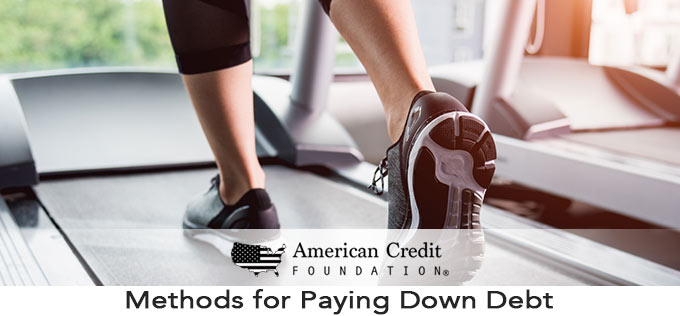Methods for Paying Down Debt

If you are in debt, you may feel like you are running on a treadmill: Every month, you pay a little to this credit card, a little to that loan, and eventually, you feel like you are getting nowhere. It doesn’t have to be that way if you are proactive and get a debt repayment strategy in place. What you need are some solid methods for paying down debt.
Everyone’s different, so the key is to choose a debt repayment strategy that is realistic enough for you to follow easily. Stick to your plan, and before you know it, you will begin moving in the right direction, chipping away at your debt. For this article, we’ll stick to high-interest credit cards.
First Things First: Your Strategy to Pay Down Debt
Before choosing the best debt repayment strategy, tally up your total debt. Make a list that includes the following:
- Debt name
- Account number
- Type of debt
- Balance
- Payment terms
- Interest rate
- Minimum monthly payment
After making your list, determine the maximum your budget allows you to pay each month on credit cards. Review your budget and figure out how much you need for necessities like rent, utilities, and groceries. To pay more toward your debt, you’ll likely need to trim the fat from your budget. The next step is to choose a strategy that works for you. Here are four methods to choose from.
- The Snowball Method
If you have more than one credit card with a balance, pay the minimum on each card while focusing the most you can on your card with the lowest balance first. This is called the snowball method because it builds momentum as it progresses. For example, you have three credit cards with the following balances: $550, $1200, and $3,000. You pay the minimum payments on the $1,200 and $3,000 balances. Your $550 balance receives the largest payment that your budget allows. Once you have repaid that card in full, move on to the $1,200 card and finally to the card with a $3,000 balance. Make sure you do not use the card you are currently paying off.

- Pay More Than the Minimum
Submitting only the minimum payment on your credit cards means you will be paying for a very long time. On the other hand, paying more than the minimum means you’ll ultimately pay less interest, which results in paying more toward the principal of your balance. You will pay the card off faster and spend less money paying your debt back.
- Debt Settlement
In a debt settlement, a creditor accepts less than what you owe. Generally, a debt settlement is a negotiation for the best terms possible. Debt settlement is a potential alternative to bankruptcy in many cases. This is excellent news; however, be cautious when settling a debt. Although debt settlement provides financial relief and puts you back on the path to rebuilding your finances, it can cause your credit score to plunge. Depending on your situation, this may not be your best bet. Debt settlement can take years to complete, depending upon the amount you owe – and you may still accumulate fees and interest rates throughout this time. The IRS views any forgiven debt over $600 as taxable income, so be prepared to pay taxes on any forgiven debt. If you choose debt settlement, be sure to work with a debt settlement company.
- Consolidate Your Debt
By consolidating your debt to one loan or credit card, you combine your high-interest cards onto a loan or credit card with a more reasonable interest rate. Balance transfer fees are typically 3% to 5%, although the lower interest you’ll be paying or the loan savings you’ll see will often outweigh the balance transfer fee. Utilizing your home equity is another possible solution to paying off high-interest cards. Home equity lines of credit generally have a lower interest rate than credit cards. Plus, there’s a bonus: Home equity interest payments are usually tax-deductible. Use caution though when considering home equity, as you will be essentially trading this unsecured debt for secured debt as it would then be tied to your home through a home equity loan.
Tried these methods of paying down debt, with little success? Still have questions and concerns about how to pay down your high-interest debt? Contact the financial experts at American Credit Foundation. Our friendly counselors will help you find the best strategy for eliminating your debt.

